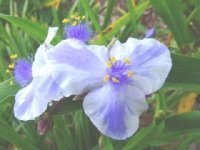Avoid Poison Ivy Peril
Springtime in the South -- when gardeners' thoughts turn to tulips and trilliums, bluebirds and bluebells. And for some of us, poison ivy. If you've ever had to endure the maddeningly itchy rash, you're not alone. Four out of five people develop skin lesions upon exposure to poison ivy, or more specifically to urushiol (oo-roo-shee-all), the oil contained in the sap. On the misery index, poison ivy ranks right up there with toothaches and long lines at the DMV.
If it seems like there's more poison ivy around than ever before, you may be right. Poison ivy prefers "edge habitats" -- disturbed areas near woodlands. With development reaching further and further into previously wooded areas, poison ivy is finding a perfect niche where civilization meets wilderness. Other woody weeds, such as Japanese honeysuckle, are also thriving.
The proliferation of poison ivy may be yet another negative impact of global warming. Duke University researchers conducted a six-year study using growth chambers to assess the impact of elevated atmospheric carbon dioxide (a leading cause of global warming) on poison ivy growth. They discovered that higher carbon dioxide levels increased photosynthesis, water use efficiency, and growth of poison ivy -- more so than for other woody plants. And the plants produce an even more toxic form of urushiol under these conditions, too.
Identifying Poison Ivy
"Leaves of three, let it be" is the easiest way to remember how to identify this plant, but it's not foolproof. Poison ivy (Toxicodendron radicans) leaves usually have three leaflets. However, occasionally they have five and sometimes up to nine leaflets. The leaves are relatively shiny and smooth (as opposed to wrinkled raspberry leaves), and the margins are usually smooth or slightly lobed (as opposed to deeply lobed oak leaves or serrated rose leaves). The plants may take the form of a woody vine, a trailing ground cover, or a free-standing shrub, so you'll need to look up, down, and all around to avoid it.
First Aid
If you know you've been exposed, there's no time to waste in treating the area -- urushiol can penetrate the skin in minutes. Unfortunately, resources offer conflicting information on treatment. The U.S. Food and Drug Administration recommends washing your skin in soap and cool water as soon as possible if you come in contact with a poison ivy plant. The U.S. Forest
Keep a stash of soap and some disposable gloves with your gardening supplies for poison ivy triage. If you can do the initial washing outdoors, you'll avoid bringing the oil into the house. Of course, the practicality of this will depend on how much clothing you need to remove and/or the proximity of your neighbors.
Prevention
If you know that there is a possibility of poison ivy on your property, it's a good idea to wash your garden tools and gloves regularly. And if you are planning to work in brushy areas where you're most likely to encounter the plant, wear long sleeves, long pants tucked into boots, and impermeable gloves. Launder your clothes separately when you're done.
An ivy block barrier is a lotion that can help prevent allergic reactions to poison ivy if it is applied at least 15 minutes before exposure. This type of product is available over-the-counter at drug stores. It works by preventing your skin from absorbing urushiol. If you are going to be working in an area where poison ivy exposure is likely, using this preventative is a good idea, but you should still cover your skin with clothing for added protection.
Eradication
If you need to get rid of poison ivy in a small area, you can try smothering it by covering the area with newspapers or cardboard and a thick layer of mulch. You'll have to keep an eye on it to make sure the vines don't find a way out. If you're not allergic you can try pulling young vines with gloved hands, but know that repeated exposure can lead to an allergic response even if you've never had one before.
The safest and surest means of eradication is with an herbicide labelled for this use, such as one with the active ingredient glyphosate. Be sure to read and follow the label instructions and precautions since different products work best when applied at different stages of the poison ivy plant's life cycle and may injure desirable plants if misapplied. Check with your local Cooperative Extension Service for advice on specific products.
For more information please click here for The National Gardening Association.








